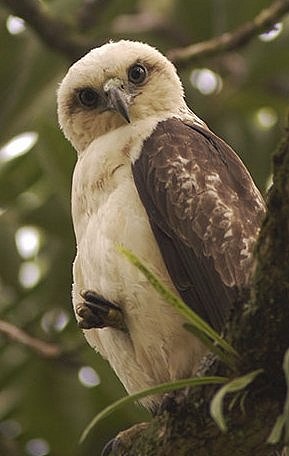Hawaiian Hawk
A species of Buzzards and Buteo Hawks Scientific name : Buteo solitarius Genus : Buzzards and Buteo Hawks
Hawaiian Hawk, A species of Buzzards and Buteo Hawks
Botanical name: Buteo solitarius
Genus: Buzzards and Buteo Hawks
Content
Description General Info
 Photo By https://www.flickr.com/photos/35188692@N00/ , used under CC-BY-2.0 /Cropped and compressed from original
Photo By https://www.flickr.com/photos/35188692@N00/ , used under CC-BY-2.0 /Cropped and compressed from original Description
The Hawaiian hawk measures approximately 40 to 46 centimeters (16 to 18 in) in length. The female, which weighs 605 g (21.3 oz) on average, is larger than the male, which averages 441 g (15.6 oz). Two color phases exist: a dark phase (dark brown head, breast, and underwings), and a light color phase (dark head, light breast and light underwings). Feet and legs are yellowish in adults and greenish in juveniles. During breeding season one of the pair, possibly the female, has a distinctive yellow forecap area just above the upper mandible. 
Size
41-46 cm (16-18 in)
Life Expectancy
17 years
Nest Placement
Tree
Feeding Habits
Hawaiian Hawk, a predator, consumes rodents, birds, insects, with selective feeding on mice, small nestlings. It hunts during daylight, showing unique dietary preferences, adapting to prey availability in its environment.
Habitat
Lowland exotic forests, agricultural lands, mid-elevation pastureland, upper-elevation native forests, closed-canopy native forests dominated by tall 'öhi'a trees, 'öhi'a-koa, or 'öhi'a mixed with exotic trees, open-canopy forests dominated by tall 'öhi'a with native-tree understory, tall 'öhi'a with native and exotic understory, or 'öhi'a with grass understory, mixed exotic and exotic-native forest along fencerows, ravines between agricultural lands, patches of guava-'öhi'a forest adjacent to pastureland, closed-canopy eucalyptus forest with open understory, closed-canopy 'öhi'a forest with a native-exotic understory within a macadamia nut orchard, open-canopy 'öhi'a forest within eucalyptus forest, scattered tall 'öhi'a and koa within pastureland
Dite type
Carnivorous
General Info
Feeding Habits
Bird food type
Species Status
Not globally threatened.

 Photo By https://www.flickr.com/photos/35188692@N00/ , used under CC-BY-2.0 /Cropped and compressed from original
Photo By https://www.flickr.com/photos/35188692@N00/ , used under CC-BY-2.0 /Cropped and compressed from original